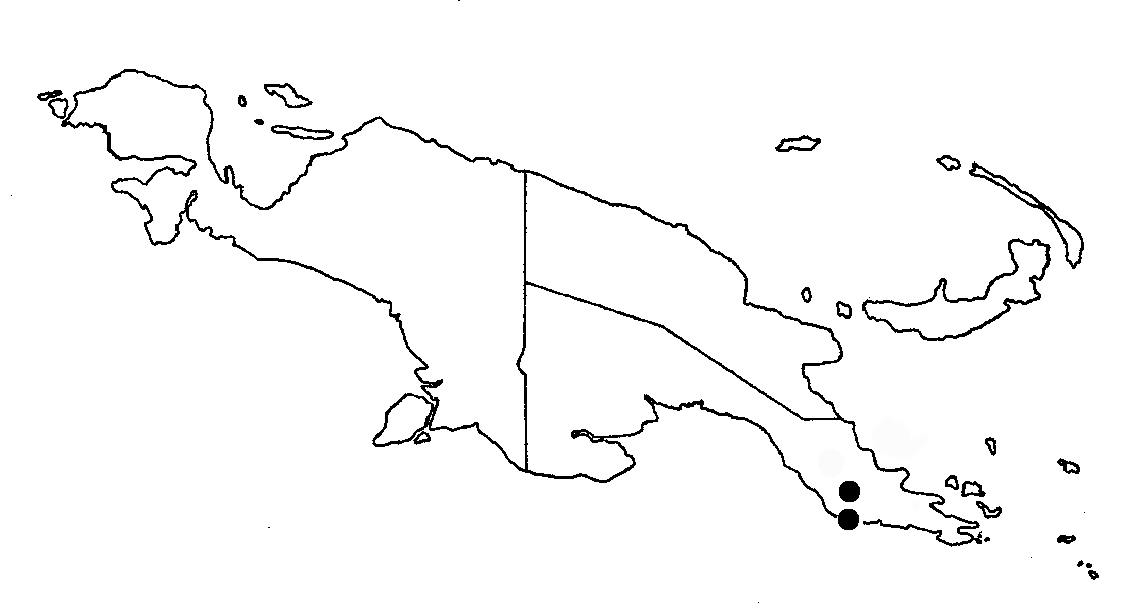
Distribution Map

Description (Barlow 1993)
Cyne perfoliata (Danser) Barlow, comb. novo
Tetradyas perfoliata Danser, Bull. Jard. Bot. Buitenzorg III, II (1931) 362. - Type: Forbes 299 (holo BM; iso MEL), New Guinea, Papua, Sogeri region, 960 m, 28.x.1885.
For descriptions see Danser, Bull. Jard. Bot.
Buitenzorg III, 11 (1931) 362; Barlow, Austral. J. Bot 22 (1974)
552 under Tetradyas perfoliata. Cyne perfoliata can be
identified by its unique character of opposite sessile leaves,
those of each pair fused at the margins in the lower 1.5-2 cm
into a sheath which completely encircles the stem and encloses
the inflorescences. The flower colour is described as pale flesh
coloured with darker nerves.
The species is distributed in eastem New Guinea (Fig. 10; 2 collections
seen), at elevations of 960 and 1500 m. Habitat details and hosts
are unknown.
Cyne perfoliata is very poorly known. Because of the very limited materials available, interpretation of the inflorescence structure has been difficult, and open flowers have not been seen. Danser (1931) interpreted the stem internodes as inflorescence peduncles, and the fused leaves as a floral involucre, and therefore failed to recognize the likely derivation of the inflorescence. Examination of the available material shows no reason for regarding these parts as other than vegetative. Danser also failed to notice an apparent operculum lining the base of the leaf in the axil. The inflorescence is therefore revealed to be a capitate, almost sessile group of triads and dyads in racemose arrangement, developing under an operculum, and the species is appropriately referred to the genus Cyne.
Cyne perfoliata is
presumably a specialized derivative of the intrusive Cyne stock
which has established on the eastern side of Charles's Line.
Description (Barlow 1974) of Tetradyas
Tetradyas Dans. Bull. Jard. bot. Buitenz. 11: 361 (1931). Type Species - T. perfoliata Dans.
Aerial stem-parasitic shrubs with opposite leaves. Inflorescence a sessile axillary head without an involucre, composed of many subsessile dyads and triads developing successively; bracts single under each flower. Characters of the mature flowers not known.
A poorly known monotypic genus, recorded only from the Central
District of Papua. The very fragmentary materials available do
not allow easy interpretation of the inflorescence structure or
affinities, but do indicate a very distinct entity. Danser (1931)
placed the genus near Papuanthes in the tribe Lorantheae,
but in my opinion the genus may be a member of the Elytrantheae,
in which similar capitate inflorescences have probably evolved
many times (cf. Lepidaria, Lepeostegeres, Thaumasianthes, Cyne,
Lampas). Danser interpreted the inflorescence as an involucrate
head on a long peduncle, but it seems more likely that the 'peduncle'
is a vegetative internode, and the 'involucre' a pair of young
leaves. The inflorescence may thus be interpreted as sessile and
axillary. In the specimens examined it appears that lateral stems
may be strongly determinate in their development, not growing
beyond the first node, so that the inflorescence appears to be
terminal.
Description (Barlow 1974) of Tetradyas perfoliata.
Tetradyas Dans. Bull. Jard. bot. Buitenz. 11: 361 (1931). Type Species - T. perfoliata Dans.
Aerial stem-parasitic shrubs with opposite leaves. Inflorescence a sessile axillary head without an involucre, composed of many subsessile dyads and triads developing successively; bracts single under each flower. Characters of the mature flowers not known.
A poorly known monotypic genus, recorded only from the Central
District of Papua. The very fragmentary materials available do
not allow easy interpretation of the inflorescence structure or
affinities, but do indicate a very distinct entity. Danser (1931)
placed the genus near Papuanthes in the tribe Lorantheae,
but in my opinion the genus may be a member of the Elytrantheae,
in which similar capitate inflorescences have probably evolved
many times (cf. Lepidaria, Lepeostegeres, Thaumasianthes, Cyne,
Lampas). Danser interpreted the inflorescence as an involucrate
head on a long peduncle, but it seems more likely that the 'peduncle'
is a vegetative internode, and the 'involucre' a pair of young
leaves. The inflorescence may thus be interpreted as sessile and
axillary. In the specimens examined it appears that lateral stems
may be strongly determinate in their development, not growing
beyond the first node, so that the inflorescence appears to be
terminal.
Illustrations
Photographs
Cyne perfoliata
updated 18 January 2007